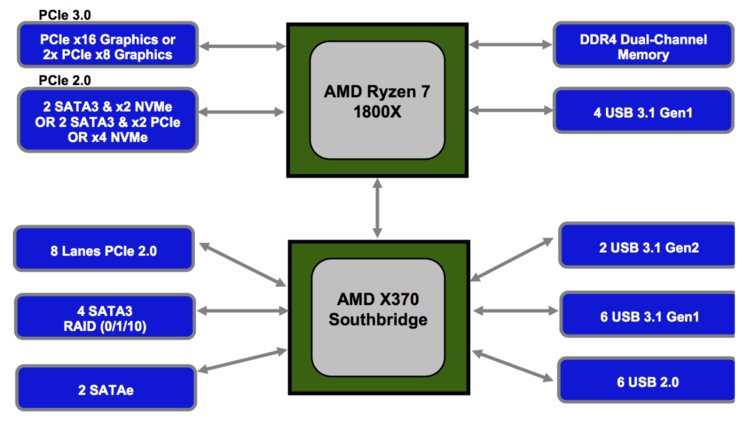AMD announced its AM4 socket and associated chipset offerings for the first time at the Bristol Ridge launch. AMD's last generation of chipset for the mainstream dates back to 2011: The 9 series came on the market at a time when USB 3.0 was just becoming mainstream and SATA-3 SSDs were just beginning to push this interface to its limits.
All Ryzen CPUs use the same AM4 socket. This gives the buyer the freedom to choose Ryzen, Bristol Ridge or Zen+ designs when purchasing an AM4 board. Reducing the number of chipsets also provides clarity for all users who are looking for special features or want to implement clearly defined configurations.
AMD has now switched to a SoC approach and offers connectivity without the detour via a North or Southbridge. Over time, (motherboard) vendors will certainly find ways to create interesting designs thanks to the CPU I/O with the additional Northbridge functionality.

Intel's Core i7-6900K offers no native USB functionality directly from the one and relies on the (X99) chipset. The Ryzen 7 1800X, on the other hand, offers four native usb 3.1 ports of the first generation. The elimination of the Southbridge and the offer of a direct connection with the chip give designers valuable space for other appendages.
In return, 40 Gen3 PCIe lanes come directly from the CPU for the 6900K, while the 1800X only has 16 dedicated lanes. The silver lining: Ryzen offers native connectivity options for both SATA and NVMe. The bottom line is that the chipsets of the two processors offer comparable connection specifications and interface options. Thanks to the converged socket, it takes fewer chipsets for Ryzen to trump.
AMD has provided AM4 with five different chipsets. Enthusiasts will want to use the X370. The B350 targets the mainstream and the A320 offers a minimum of freedom for basic configurations. Those who like to use AMD APUs in HTPCs and LAN boxes will be able to use the X300 and A/B300 chipsets in the future, although their details are still open.
Focusing on enthusiast and mainstream markets, the X370 and B350 chipsets are the logical choice for us. X370 and B350 follow the same trend as their older brothers 990FX and 970: the higher-quality chipset gets more I/O options and functionality.
If you use the X370, you can look forward to four additional USB 3.1 Gen1 ports, two additional SATA 3 ports and two extra PCIe-Gen2 lanes. Ryzen systems now officially support both CrossFire and SLI configurations, an important advantage compared to the X370 and the older 990FX.
Another drawback of the B350 is the lack of official AMD support for additional PCIe x16 slots. Both AM4 chipsets support overclocking, RAID 0/1/10 and SATAe directly from the factory. AMD's documentation states that SATAe ports can also be used as additional SATA ports or PCIe-Gen2 lanes, potentially allowing larger arrays or additional M.2 ports.
AMD's Ryzen processors, along with the new AM4 chipsets, provide a host of native support for I/O configurations. According to AMD, the AM4 socket is to be used until 2020 – which means good future security. Until then, other technologies such as DDR5 and PCI Gen4 will have made their wait, which will then have to be used as well as new platforms.
- 1 - Das Ryzen-Debüt
- 2 - AMD SenseMI Suite & XFR
- 3 - Die AM4-Plattform
- 4 - Overclocking und Test-Setup
- 5 - Power States und Cache-Tests
- 6 - Benchmarks: Ashes of the Singularity & Battlefield 4
- 7 - Benchmarks: Hitman, Project CARS & Metro: Last Light
- 8 - Ergebnisse: Desktop und Office
- 9 - Ergebnisse: Workstation
- 10 - Ergebnisse: Wissenschaftlich-technische Berechnungen und HPC
- 11 - Ergebnisse: Leistungsaufnahme und Abwärme
- 12 - Fazit

































Kommentieren